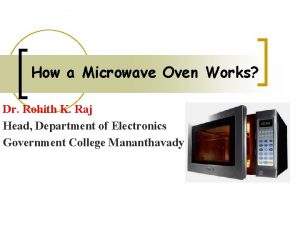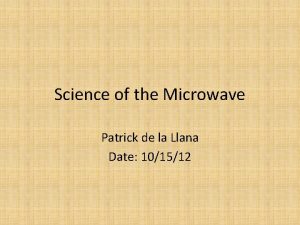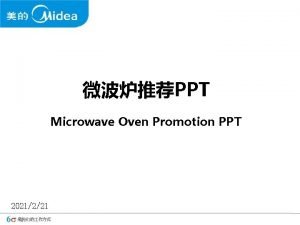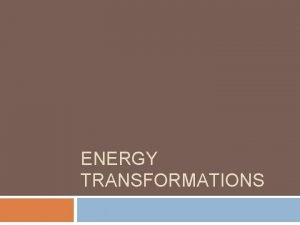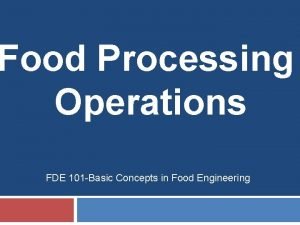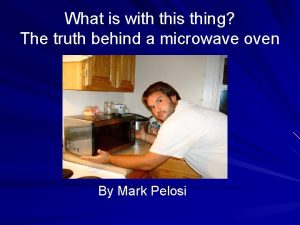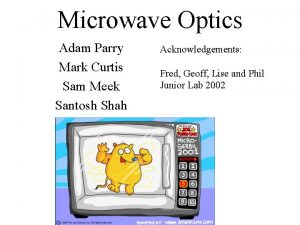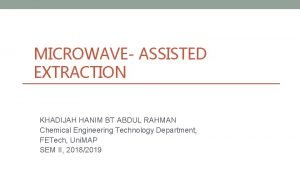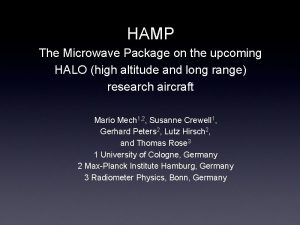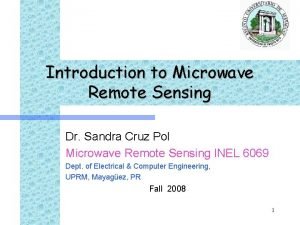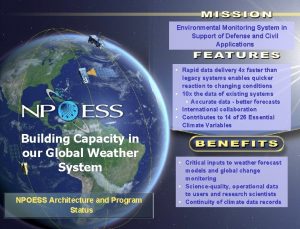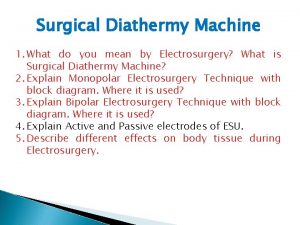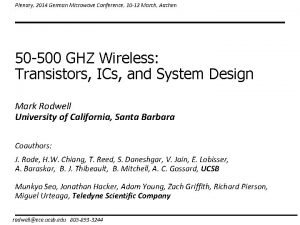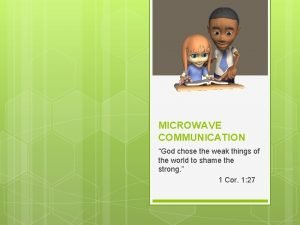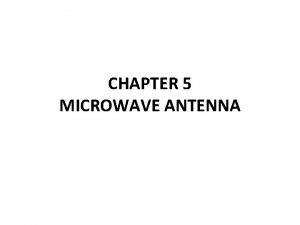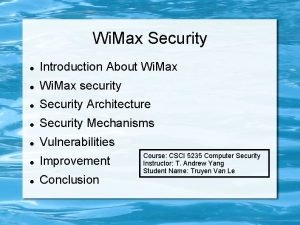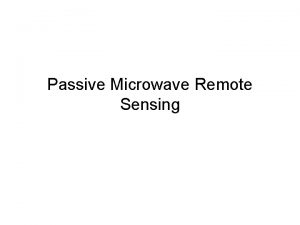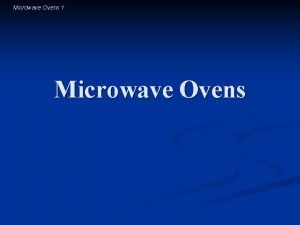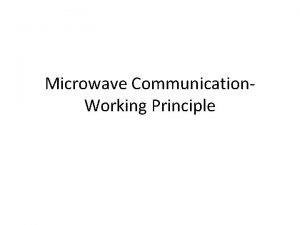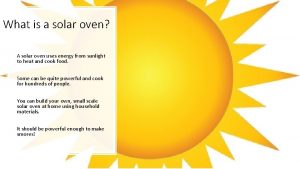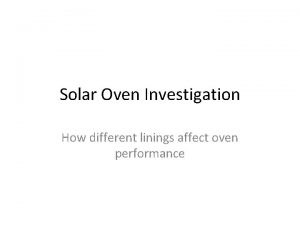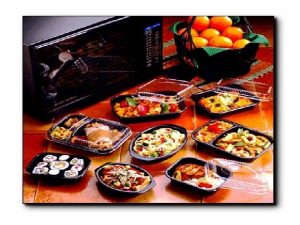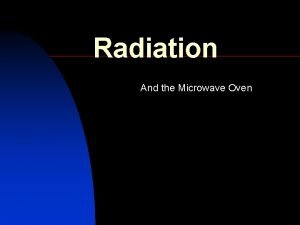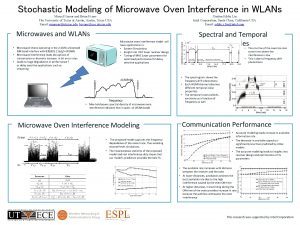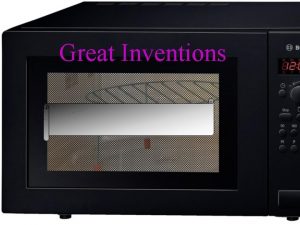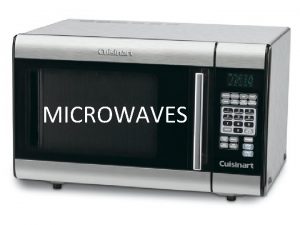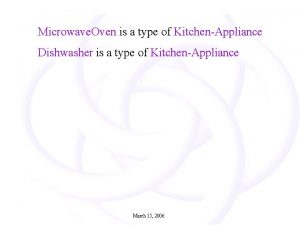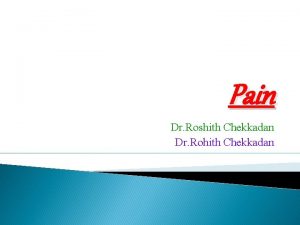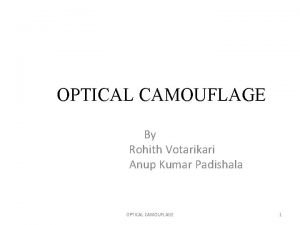How a Microwave Oven Works Dr Rohith K



















- Slides: 19

How a Microwave Oven Works? Dr. Rohith K. Raj Head, Department of Electronics Government College Mananthavady

Salient features of Microwave Oven • Saves Time • Nutritious values of food are retained • Moderate Power consumption • Easy to use • Easy transportation • Easy maintenance • Pollution free

What are Microwaves? n Microwaves are a form of electromagnetic energy, like light waves or radio waves n Microwaves are used extensively in communications ¡ such as to relay long-distance telephone signals, television programs and computer information across the earth or to a satellite in space. n Good for transmitting information because it can penetrate light rain and snow, clouds, and smoke. n Also used in radars and in detecting speeding cars. n Microwave has become most familiar as the energy source for cooking food.

Electromagnetic Spectrum Band Name Frequency Range Common Application VLF Very Low Frequency 3 KHz--------------------- 30 KHz Electronic Toys & Equipments LF/ LW Low Frequency/ Long Wave 30 KHz--------------------300 KHz Commercial Radio Broadcast MF/ MW Medium Frequency/ Medium Wave 300 Khz---------------------3 Mhz Commercial Radio Broadcast HF/ SW High Frequency/ Short Wave 3 MHz---------------------30 MHz Commercial Radio Broadcast & Walky Talkies VHF Very High Frequency 30 Mhz--------------------300 MHz Commercial TV, Radio Broadcast & Cordless Phones UHF Ultra High Frequency 300 MHz--------------------3 GHz Commercial TV Broadcast & Microwave Oven SHF Super High Frequency 3 GHz---------------------30 GHz RADAR, Satellite TV Transmission EHF Extremely High Frequency 30 GHz--------------------300 GHz Merchant Navy & Space Stations Microwaves are usually represented in GHz

Applications of Microwaves Imaging Remote Satellite communication Communication Tower MICROWAVE OVEN 5 Mobiles

Three Basic Properties of Microwaves 1. Microwaves can pass through Glass, Paper, Plastic & Organic materials. 2. Microwaves are reflected by metal surfaces. 3. Microwaves penetrate and are absorbed by some substances like fats, sugar, water molecules

History n n Invented accidentally by Dr. Percy Le. Baron Spencer While testing a magnetron during work, he discovered the candy bar in his pocket melted Experimented with other food products (popcorn and eggs), and realized microwaves can cook foods quickly At 1947, 1 st commercial microwave oven produced (called Radarange) ¡ n Mostly used by restaurants, railroad cars, ocean liners and military Improvement and refinements made ~ by 1967, 1 st domestic microwave oven produced

How the Oven Works

How the Oven Works • • • The magnetron converts the high voltage in to the microwave frequency for cooking The microwave energy is transmitted into a waveguide When the door is opened, or the timer reaches zero, the microwave energy stops.

Components used in Microwave Oven Power Cord RFI Filter Monitor Switch Primary Switch Secondary Switch Interlock Switches Grill Heater

Components used in Microwave Oven Convection Heater Convection Motor Fan Motor Thermal Cutout

Components used in Microwave Oven Turntable Motor HV Diode Magnetron HV Capacitor

Components used in Microwave Oven HV Transformer Thermistor PCB Oven Lamp

MAGNETRON

Travelling electron bunches

How Foods Get Cooked ?

How Foods Get Cooked n n The microwaves that penetrate the food have an electric field that oscillates 2. 45 billion times a second, a frequency that is well absorbed by polar liquid molecules such as water, sugars, fats and other food molecules. Water interacts with the microwave: ¡ ¡ n n flipping its orientation back and forth very rapidly bumping into one another and producing heat, cooking the food. Glass, paper, ceramic, or plastic containers are used in microwave cooking because the microwaves pass through them Metal reflects microwaves ¡ Unsafe to have metal pans/aluminum foil in oven, may damage oven

Health Hazards n n It is known that microwave radiation can heat body tissue the same way it heats food. Exposure to high levels of microwaves can cause a painful burn ¡ n Still uncertain in the effects of humans from long term exposure to low level of microwaves ¡ n Ex. the lens of the eye ~ exposure to high levels of microwaves can cause cataracts. Still experimenting Best to stay a way (an arm’s length) in reducing exposure to microwaves

Thank you ……
 How microwave oven works
How microwave oven works Percy spencer the inventor of the microwave oven igcse
Percy spencer the inventor of the microwave oven igcse State diagram for microwave oven
State diagram for microwave oven Microwave photonics ppt
Microwave photonics ppt Oven energy conversion
Oven energy conversion How the microwave works
How the microwave works Safety at street works and road works pdf
Safety at street works and road works pdf Percy spencer
Percy spencer Sam meek
Sam meek Microwave assisted extraction
Microwave assisted extraction Microwave device package
Microwave device package Introduction to microwave remote sensing
Introduction to microwave remote sensing Microwave
Microwave Advanced technology microwave sounder
Advanced technology microwave sounder Electrosurgical unit block diagram
Electrosurgical unit block diagram Conclusion of breast self examination
Conclusion of breast self examination German microwave conference
German microwave conference Barnett vignant equation
Barnett vignant equation Types of microwave antenna
Types of microwave antenna Worldwide interoperability for microwave access (wimax)
Worldwide interoperability for microwave access (wimax)
